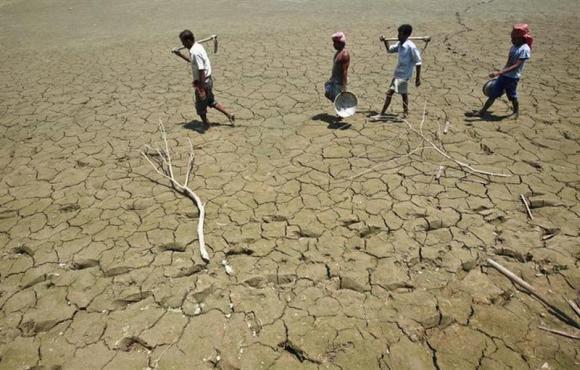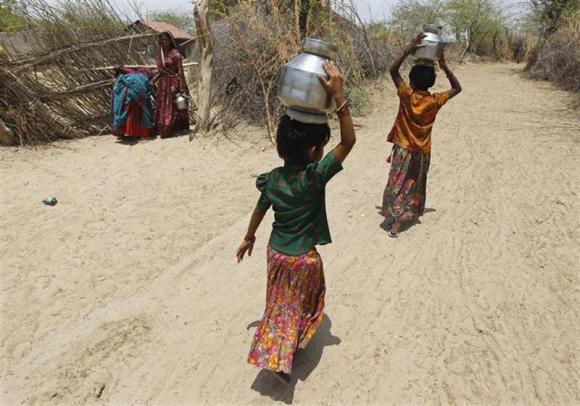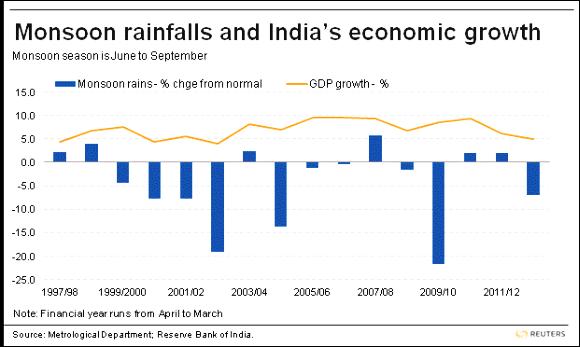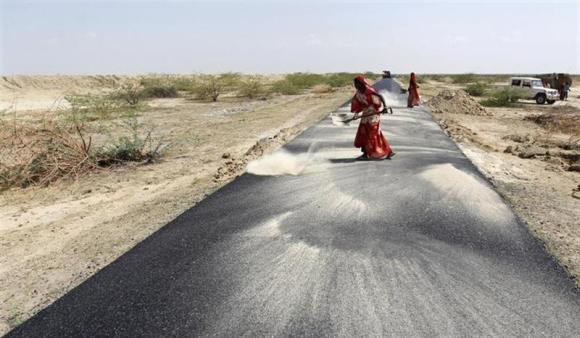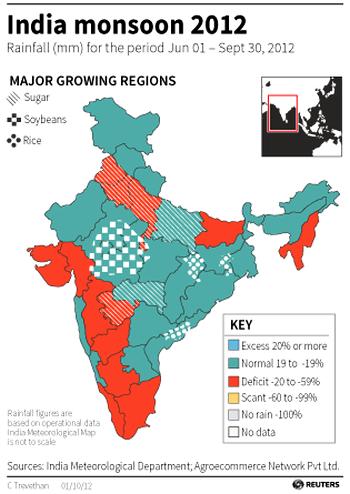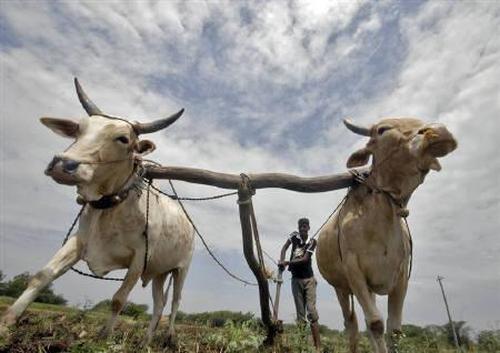 | « Back to article | Print this article |
Why good monsoon may not revive economy
India has more variations in soil type and climate than perhaps any other region in the world. Even during a normal monsoon season, many regions receive scanty rainfall while other battle with floods.
India may be heading for another bumper grain harvest, if the first forecast for this year's monsoon proves correct, but the rain may be too little - and too late - for southern and western states already parched by the worst drought in four decades.
Although last year's monsoon rains were, overall, just 7 per cent below normal, these states - including major sugar producer Maharashtra and cotton-growing Gujarat - went short, in some cases getting less than half the precipitation they needed.
A further drought this year could trigger mass migration to cities like Mumbai as families seek jobs and precious water. It would also hit crops, shrinking farm incomes and so reducing economic growth in the area, as well as fuelling food inflation.
India's struggling economy, Asia's third biggest, is at last showing some green shoots of recovery, but anything short of a drought-busting monsoon could put that at risk.
Click NEXT to read more...
Why good monsoon may not revive economy
A drought can wipe as much as 2 percentage points off economic growth, as farm output withers and consumption stalls.
"If the monsoon season is good, then farmers will earn money and start spending from October onwards. Till then we have to cope with the slowdown," said Kamalkant Deshmukh, a manager at Raghuvir Motors, which sells Hero motorcycles in Aurangabad in Maharashtra.
His sales halved in the first three months of 2013 from a year ago, while overall motorcycle sales dropped an annual 8.3 per cent in March.
A widespread drought could push the overall economic growth rate in the current fiscal year ended March, 2014, down to as low as 5.1 per cent from a current projection of 6 per cent, said D.K. Joshi, chief economist at CRISIL Ltd.
Click NEXT to read more...
Why good monsoon may not revive economy
Last Friday, global experts predicted that India would receive normal monsoon rains this year, and the country's weather office is likely to confirm that with its own first official forecast on April 26.
But the massive subcontinent, which stretches from the tropics in the south to the Himalayas in the north, has more variations in soil type and climate than perhaps any other region in the world. Even during a normal monsoon season, many regions receive scanty rainfall while other battle with floods.
Wells Dry Up
The June-September rains are crucial for the 55-60 per cent of the farmland that lacks irrigation. Drought damages crops and yields, sometimes forcing the country to import food for its 1.2 billion population, spurring global prices higher.
Last year's rains were successful enough to mean sugar, rice and wheat output are all surplus to demand and, in some cases, breaking records.
Click NEXT to read more...
Why good monsoon may not revive economy
Government grain stocks are already overflowing and New Delhi is pushing exports to avoid wasting the rice and wheat to rot and rodents.
But the devil is in the detail.
Farmer Sanjay Wadekar from the village of Jamwadi in Maharashtra watched helplessly in recent weeks as wells on his land dried up and his 17-year-old sweet lime orchard died.
Now, he is planting cotton in the hope that the hardier, less thirsty crop will survive and bring some income.
"Due to the drought, I have lost my savings of the last few years. If the drought repeats again this year, I have no choice but to default on crop and tractor loans. I may have to sell some family gold for regular expenses," said Wadekar.
Click NEXT to read more...
Why good monsoon may not revive economy
Sugar Cane Used To Feed Cows
Maharashtra, Gujarat and Rajasthan in the west and the southern states of Karnataka, Tamil Nadu, Kerala and Andhra Pradesh are all in desperate need of ample rains this year, spanning an area roughly equivalent to Southern Europe.
According to some estimates, sugar output may drop below demand for the first time in four years in 2013-14 because the drought in Tamil Nadu, Maharashtra and Karnataka has reduced planting.
Sugar output has already been cut by 17 per cent in Maharashtra, India's main producing state, and its grains production is down a similar amount.
Cotton output has also been hit, down over 29 per cent in Gujarat, while Maharashtra's onion production - key for the spicy dishes - is likely to drop more than 19 percent.
Click NEXT to read more...
Why good monsoon may not revive economy
In addition, states have bought sugar cane for fodder to ensure the survival of dairy cows, which become the main source of income for farmers when drought hits their crops.
The drought is so bad in Maharashtra that drinking supplies are running short. Nearly 12,000 villages have been affected and tanker trucks are out supplying water. People in Jamwadi have to trudge nearly 2 km to find wells which still hold water.
"Many of our relatives are moving to Mumbai, where they are getting work and tap water," said 25-year-old Salma Beniwale, on her third round trip to the well on a recent day. "We are also thinking to go there as I don't think we will get water in May."
And it's not just drinking water that is precious.
"People have no choice but to defecate in the open," said Bajirao More, a farm labourer currently without work in Jamwadi. "Here we are struggling to secure drinking water. Using toilets means we have to make one more round to bring water."

© Copyright 2025 Reuters Limited. All rights reserved. Republication or redistribution of Reuters content, including by framing or similar means, is expressly prohibited without the prior written consent of Reuters. Reuters shall not be liable for any errors or delays in the content, or for any actions taken in reliance thereon.
